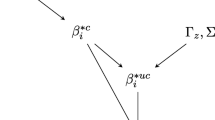Abstract
We investigate direct and indirect specification of the distribution of consumer willingness-to-pay (WTP) for changes in product attributes in a choice setting. Typically, choice models identify WTP for an attribute as a ratio of the estimated attribute and price coefficients. Previous research in marketing and economics has discussed the problems with allowing for random coefficients on both attribute and price, especially when the distribution of the price coefficient has mass near zero. These problems can be avoided by combining a parameterization of the likelihood function that directly identifies WTP with a normal prior for WTP. We show that the typical likelihood parameterization in combination with what are regarded as standard heterogeneity distributions for attribute and price coefficients results in poorly behaved posterior WTP distributions, especially in small sample settings. The implied prior for WTP readily allows for substantial mass in the tails of the distribution and extreme individual-level estimates of WTP. We also demonstrate the sensitivity of profit maximizing prices to parameterization and priors for WTP.

Similar content being viewed by others
Notes
The reservation price is the price that induces indifference between purchase and non-purchase in the category. The equalization price (Swait et al.1993) is the price that induces indifference between two choice alternatives within the category.
We adopt a fully Bayesian approach to inference in this paper. However, the points made apply in the context of hierarchical models independent of the estimation technique.
Another motivation for directly parameterizing the model in WTP terms is that the researcher often has variables such as demographics that may be useful in the characterization of consumer heterogeneity. In such instances it seems more reasonable to build hierarchical regression structures for WTP instead of parameters with less clear interpretation. We do not explore this issue here.
Note that the median of the posterior mean of the individual-level estimates will not be the same as the posterior mean of the median of the population distribution.
References
Allenby, G., & Lenk, P. (1994). Modeling household purchase behavior with logistic normal regression. Journal of the American Statistical Association, 89, 1218–1231.
Andrews, R., Ainslie, A., & Currim, I. (2002). An empirical comparison of logit choice models with discrete vs. continuous representations of heterogeneity. Journal of Marketing Research, 39, 479–487.
Arora, N., Allenby, G. M., & Ginter, J. L. (1998). A disaggregate model of primary and secondary demand. Marketing Science, 17(1), 29–44.
Cameron, T., & James, M. (1987). Estimating willingness-to-pay from survey data: An alternative pre-test-market evaluation procedure. Journal of Marketing Research, 24, 389–395.
Edwards, Y., & Allenby, G. (2003). Multivariate analysis of multiple response data. Journal of Marketing Research, 40, 321–334.
Gilbride, T., & Allenby, G. (2004). A choice model with conjunctive, disjunctive, and compensatory screening rules. Marketing Science, 23, 391–406.
Jedidi, K., Jagpal, S., & Manchanda, P. (2003). Measuring heterogeneous reservation prices for product bundles. Marketing Science, 22, 107–130.
Jedidi, K., & Zhang, J. (2002). Augmenting conjoint analysis to estimate consumer reservation prices. Management Science, 48, 1350–1368.
Liechty, J., Fong, D., & DeSarbo, W. (2005) Dynamic models incorporating individual heterogeneity: Utility evolution in conjoint analysis. Marketing Science, 24, 285–293.
Meijer, E., & Rouwendal, J. (2006) Measuring welfare effects in models with random coefficients. Journal of Applied Econometrics, 21, 227–244.
Newton, M. A., & Raftery, A. E. (1994). Approximate bayesian inference by the weighted likelihood bootstrap. Journal of the Royal Statistical Society. Series B, 56, 43–48.
Orme, B. (2001). Assessing the monetary value of attribute levels with conjoint: Warnings and suggestions. Sawtooth Solutions Customer Newsletter (Spring), Sequim, WA: Sawtooth Software, Inc.
Revelt, D., & Train, K. (1998) Mixed logit with repeated choices: Households’ choices of appliance efficiency level. Review of Economics and Statistics, 4, 647–657.
Rossi, P., Allenby, G., & McCulloch, R. (2005) Bayesian Statistics and Marketing. England: Wiley.
Shaffer, G., & Zhang, J. (1995). Competitive coupon targeting. Marketing Science, 14, 395–416.
Shaffer, G., & Zhang, J. (2000). Pay to switch or pay not to switch: Third degree price discrimination in markets with switching costs. Journal of Economics & Management Strategy, 9, 397–424.
Spiegelhalter, D., Best, N., Carlin, B., & van der Linde, A. (2002) Bayesian measures of model complexity and fit. Journal of the Royal Statistical Society B, 64, 583–639.
Swait, J., Erdem, T., Louviere, J., & Dubelaar, C. (1993). The equalization price: A measure of consumer-perceived brand equity. International Journal of Research in Marketing, 10, 23–45, (March).
Train, K. (2003) Discrete choice methods with simulation. Cambridge: Cambridge University Press.
Zellner, A. (1978). Estimation of functions of population means and regression coefficients including structural coefficients: A minimum expected loss (MELO) approach. Journal of Econometrics, 8, 127–158.
Acknowledgement
The authors would like to thank Peter Rossi, JP Dubé, Jordan Louviere, Kenneth Train, and Greg Allenby for helpful insights. We also thank seminar participants at The Ohio State University, Duke University, University of Michigan and the University of Chicago for providing useful comments.
Author information
Authors and Affiliations
Corresponding author
Rights and permissions
About this article
Cite this article
Sonnier, G., Ainslie, A. & Otter, T. Heterogeneity distributions of willingness-to-pay in choice models. Quant Market Econ 5, 313–331 (2007). https://doi.org/10.1007/s11129-007-9024-6
Received:
Accepted:
Published:
Issue Date:
DOI: https://doi.org/10.1007/s11129-007-9024-6




